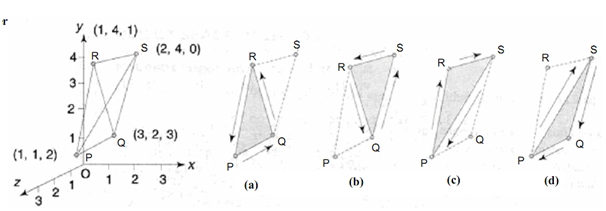Example of Back Face Detection Method:
To illustrate the method, we will start with the tetrahedron (pyramid) PQRS of Figure, with vertices P (1, 1, 2), Q (3, 2, 3), R (1, 4, 1), and S (2, 4,0). It is clearly a convex object, re-entrant angles just not being possible with triangles. In this case we can be able to guess that the vertex S is behind the triangle PQR, and also that faces PQR & QRS are visible, and the other two faces PQS & PRS are hidden. But the computer should be able to decide for itself and we too cannot decide for more than one tetrahedron.
So, let us start with the order PQR as counter-clockwise with the triangle facing the viewer, as illustrated by the arrows along the edges in Figure (a). Then, for the adjacent triangle QRS, at its common edge QR with the triangle PQR, the arrow should point in the opposite direction, namely from R to S as shown, and therefore the vertices should indeed be ordered as RQS (or QSR, or SRQ), as in Figure (b).
The vertex sequences of the other two triangles are also followed by the same logic
: For the triangle PRS, from the common edge PR along triangle PQR, the vertex sequence must be PRS (or RSP, or SPR), as in Figure (c). We could have also utilized the common edge RS with triangle QRS to get the similar result. For triangle PQS, from anyone of the three common edges with the other three triangular faces, the vertex sequence shall be determined as PSQ (or SQP, or QPS), as in Figure (d).

Figure: Back-Face Detection Method Naming Directions